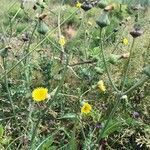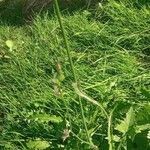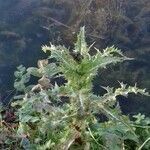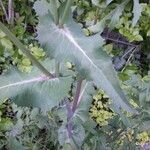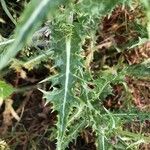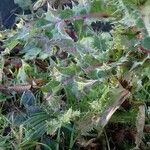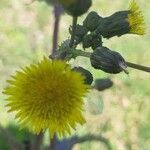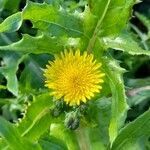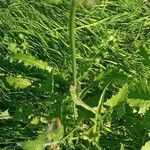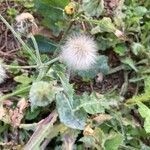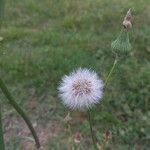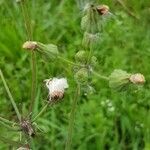Herbs 20-50 cm tall, annual. Stem usually unbranched and glabrous below synflorescence. Basal and lower stem leaves extremely variable, obovate, spatulate, or elliptic, 7-13 × 2-5 cm, undivided or ± irregularly pinnatisect, glabrous, adaxially dark green and ± glossy, base attenuate and ± auriculate, margin usually densely spinulosely dentate, apex acute, acuminate, or obtuse; lateral lobes ± triangular, semiorbicular, or elliptic. Middle and upper stem leaves spatulate to lanceolate, base auriculately clasping with conspicuous rounded and appressed auricles, otherwise similar to lower leaves. Synflorescence densely corymbiform, with few to some capitula. Capitula with many florets; peduncle 0.5-5 cm, slender, glabrous or densely glandular hairy. Involucre ± campanulate, ca. 1.2 cm. Phyllaries abaxially glabrous or more rarely glandular hairy, apex acute; outer phyllaries narrowly lanceolate, 1-2 mm wide. Corolla ca. 1 cm. Achene ± broadly obcolumnar, 2-3 mm, strongly compressed, ± winged, between lateral ribs usually with 3 slender ribs on either side, space between slender ribs much wider than ribs, smooth with only lateral ribs usually antrorsely finely spinulose. Pappus ca. 7 mm, ± caducous. Fl. and fr. May-Oct. 2n = 18.
Annual or biennial. Roots tap and fibrous. Stem erect, usually simple, finely grooved or ribbed, glabrous, (15)-20-60-(180) cm tall. Lvs firm-textured, ± shiny, usually green or rarely glaucous above, paler to ± glaucous beneath, glabrous, lanceolate to oblanceolate or obovate; margins sinuate-dentate with prickly-spinose teeth. Rosette and lower stem lvs tapering to expanded auriculate base, (4)-10-20-(40) × (1.5)-3-6-(15) cm, pinnatifid to c. 1/2 way to midrib or rarely not lobed; lobes recurved to spreading, triangular to lanceolate. Upper lvs pinnatifid or not lobed, narrowly triangular to subulate, with rounded amplexicaul auricles at base. Infl. cymose to umbellate; capitula few to many. Involucre 10-15 mm long, turbinate to cylindric; bracts imbricate, reflexed at fruiting, glabrous or rarely with tangled white short branching hairs and sparse long pale glandular hairs. Receptacle glabrous. Florets 11/2× length of involucre; corolla tube > ligule; ligules spreading, yellow. Achenes elliptic, pale brown, strongly flattened, 2.5-3 × 1-1.6 mm, 3-ribbed on each face, winged; spaces between ribs smooth; ribs and edges of wings smooth or finely scabrid. Pappus fine, white, c. = involucre.
Annual to c. 1.2 (–2) m high, with rosette variously developed. Leaves to c. 30 cm long, with l:w ratio 1–5 (–8), divided or not, thin to coriaceous, sometimes semi-rigid at margin; base above mid-stem strongly stem-clasping, with auricles rounded basally, strongly down-turned and arching back toward apex; margin denticulate or toothed, with spiny tips 0.5–5 mm long, somewhat prickly or not; divided leaves lobed to subpinnatisect, with up to 8 usually spreading or slightly retrorse lobes or segments per side; terminal segment usually not or hardly larger than lateral segments; uppermost leaves mostly ovate to narrowly ovate. Capitula few–many; involucre 8–13 mm long, 3–8 mm diam.; outer and intermediate bracts ovate to lanceolate. Florets: ligule 4–5 mm long, shorter than tube; style hairs dark. Achenes elliptic or slightly obovate, 2.0–3.2 mm long, 0.8–1.8 mm wide, strongly compressed, distinctly winged, without transverse wrinkles, usually minutely scabridulous on margin; marginal achenes pale yellow and central ones orange-brown. Pappus 7–9 mm long.
Simple, erect, annual or perennial herb, up to 1.5 m high, with milky latex. Stems hollow, reddish purple-tinged, glabrous or sometimes ± densely glandular-setose. Leaves in a basal rosette, as well as alternate upwards (subsp. glaucescens), glabrous, oblanceo-late-panduriform, seldom pinnatifid, sinuate-dentate to runcinate-pinnatilobed, apices acute, margins irregularly dentate, basal auricles rounded and appressed, semi-am-plexicaul, margins spinulose-dentate, lower leaves exauriculate and with petiole-like midribs, upper leaves smaller and sessile. Capitula ligulate, stalked, in corymbi-form, cymose clusters; involucral bracts in many rows, imbricate, densely white-tomentose at base, soon glabrescent. Florets 5-lobed, pale yellow. Flowering time Aug., Nov. Pappus of many, white, barbellate bristles intermixed with down-like hairs. Cypselae reddish brown, broadly oblong-ellipsoid, strongly compressed with broad marginal wings which are ciliate and recurved, body ribbed and rugulose, < 3 mm long.
Annual or sometimes perennial herb, erect, 0.2-2 m high; stems sparsely branched, stout, hollow, ribbed, reddish-purple proximally, glabrous or sometimes densely glandular-setose. Leaves glaucous, sometimes reddish, oblanceolate or slightly panduriform in outline, 4-32 cm long, 1-9 cm wide, base amplexicaul with large, rounded auricles except in the most basal leaves which are attenuate at base, margins dentate to pinnatilobed with wide retrorse triangular lobes, the teeth spinulose, apex acute, glabrous. Capitula stalked, in many-headed corymbs; involucre 12-14 mm long; phyllaries ovate to lanceolate, 2-14 mm long, acute, glabrous or with large setae on the midrib in the outer ones. Florets many; corolla yellow, tube cylindric, 6 mm long, distally pilose, ligule 4-5 mm long, 0.5-1.0 mm wide. Achenes reddish brown, broadly obovoid to ellipsoid, 2.5-3.5 mm long, strongly flattened, with wing-like margins, ribbed, smooth or minutely rugulose; pappus white, 6-9 mm long.
Annuals or biennials, 10–120(–200+) cm. Stem bases soft, herbaceous, hollow. Leaves: blades of mid cauline spatulate or oblong to obovate or lanceolate, 6–30 × 1–15 cm, bases auriculate, auricles often recurved or curled, rounded, margins often pinnately lobed, lobes ± deltate (not constricted at bases), terminals usually larger than laterals, usually prickly-dentate. Peduncles usually stipitate-glandular, sometimes glabrous. Involucres 9–13+ mm. Phyllaries usually stipitate-glandular. Corollas: ligules mostly shorter than tubes. Cypselae stramineous to reddish brown, mostly ellipsoid, strongly compressed, ± winged, 2–3 mm, ribs 3(–5) on each face, faces smooth across and between ribs; pappi 6–9 mm. 2n = 18.
An erect annual herb. It grows to 1 m high. The stems are hollow. There is milky sap when the stems are cut. There are some glands on the upper parts. The leaves are 5-15 cm long. The leaves half clasp the stem. They have rounded ear like structures at the base. The edges can be spiny or have teeth. The plants are bluish-green. The flower heads are yellow. They are 1-2 cm across. They are crowded in irregular heads. The fruit is a dry fruit.
Much like no. 2 [Sonchus oleraceus L.] commonly more prickly; lvs pinnatifid, or frequently obovate and lobeless, with rounded and conspicuously prickly-toothed, not acute auricles; cor-tube somewhat longer than the ligule; achenes flatter, with 3(4–5) evident ribs on each face, not rugulose, although there may be minute projections from the marginal ribs; 2n=18. A cosmopolitan weed, native to Europe. July–Oct.
